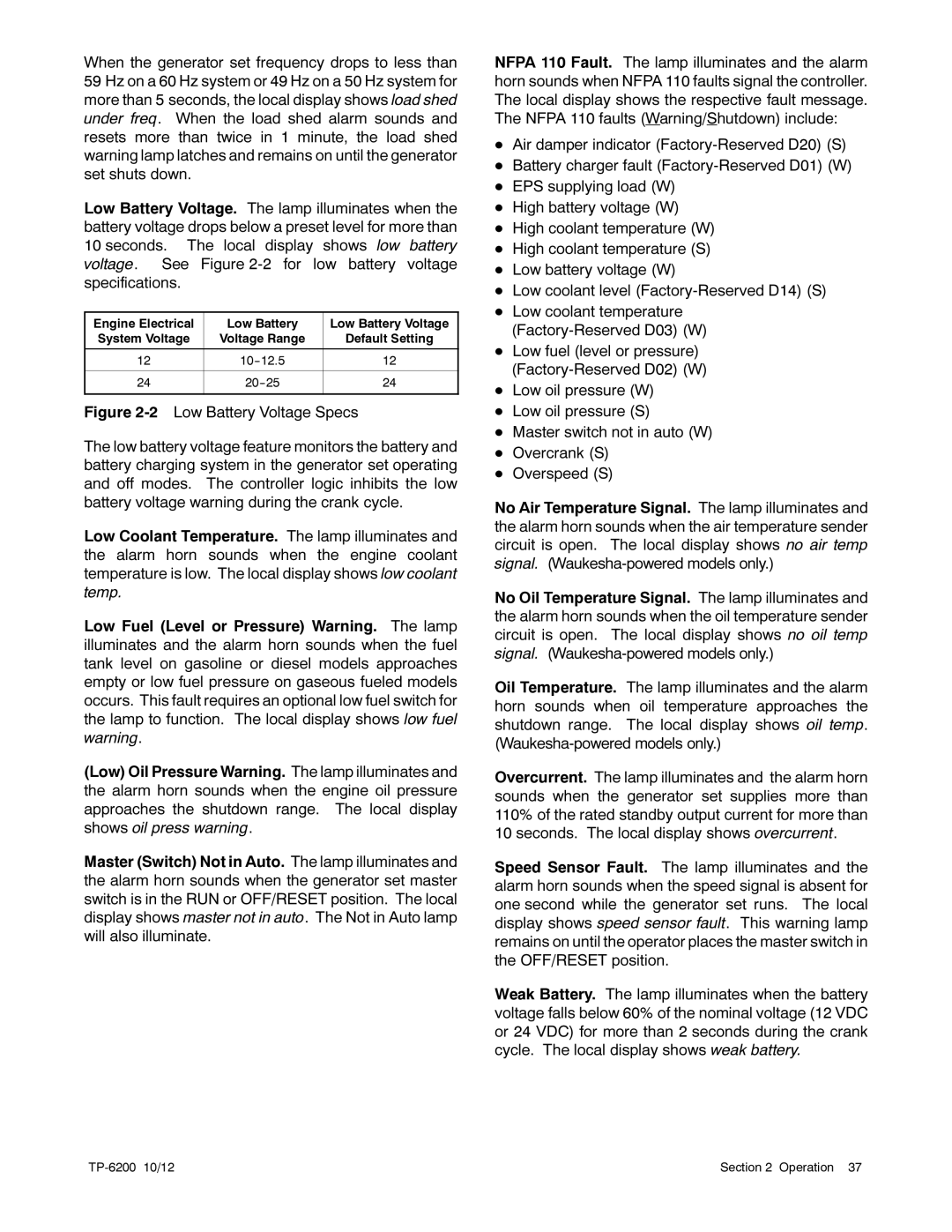When the generator set frequency drops to less than
59Hz on a 60 Hz system or 49 Hz on a 50 Hz system for more than 5 seconds, the local display shows load shed under freq. When the load shed alarm sounds and resets more than twice in 1 minute, the load shed warning lamp latches and remains on until the generator set shuts down.
Low Battery Voltage. The lamp illuminates when the battery voltage drops below a preset level for more than 10 seconds. The local display shows low battery voltage. See Figure
Engine Electrical | Low Battery | Low Battery Voltage |
System Voltage | Voltage Range | Default Setting |
|
|
|
12 | 12 | |
|
|
|
24 | 24 | |
|
|
|
Figure 2-2 Low Battery Voltage Specs
The low battery voltage feature monitors the battery and battery charging system in the generator set operating and off modes. The controller logic inhibits the low battery voltage warning during the crank cycle.
Low Coolant Temperature. The lamp illuminates and the alarm horn sounds when the engine coolant temperature is low. The local display shows low coolant temp.
Low Fuel (Level or Pressure) Warning. The lamp illuminates and the alarm horn sounds when the fuel tank level on gasoline or diesel models approaches empty or low fuel pressure on gaseous fueled models occurs. This fault requires an optional low fuel switch for the lamp to function. The local display shows low fuel warning.
(Low) Oil Pressure Warning. The lamp illuminates and the alarm horn sounds when the engine oil pressure approaches the shutdown range. The local display shows oil press warning.
Master (Switch) Not in Auto. The lamp illuminates and the alarm horn sounds when the generator set master switch is in the RUN or OFF/RESET position. The local display shows master not in auto. The Not in Auto lamp will also illuminate.
NFPA 110 Fault. The lamp illuminates and the alarm horn sounds when NFPA 110 faults signal the controller. The local display shows the respective fault message. The NFPA 110 faults (Warning/Shutdown) include:
DAir damper indicator (Factory-Reserved D20) (S)
DBattery charger fault (Factory-Reserved D01) (W)
DEPS supplying load (W)
DHigh battery voltage (W)
DHigh coolant temperature (W)
DHigh coolant temperature (S)
DLow battery voltage (W)
DLow coolant level (Factory-Reserved D14) (S)
DLow coolant temperature (Factory-Reserved D03) (W)
DLow fuel (level or pressure) (Factory-Reserved D02) (W)
DLow oil pressure (W)
DLow oil pressure (S)
DMaster switch not in auto (W)
DOvercrank (S)
DOverspeed (S)
No Air Temperature Signal. The lamp illuminates and the alarm horn sounds when the air temperature sender circuit is open. The local display shows no air temp signal. (Waukesha-powered models only.)
No Oil Temperature Signal. The lamp illuminates and the alarm horn sounds when the oil temperature sender circuit is open. The local display shows no oil temp signal. (Waukesha-powered models only.)
Oil Temperature. The lamp illuminates and the alarm horn sounds when oil temperature approaches the shutdown range. The local display shows oil temp. (Waukesha-powered models only.)
Overcurrent. The lamp illuminates and the alarm horn sounds when the generator set supplies more than 110% of the rated standby output current for more than 10 seconds. The local display shows overcurrent.
Speed Sensor Fault. The lamp illuminates and the alarm horn sounds when the speed signal is absent for one second while the generator set runs. The local display shows speed sensor fault. This warning lamp remains on until the operator places the master switch in the OFF/RESET position.
Weak Battery. The lamp illuminates when the battery voltage falls below 60% of the nominal voltage (12 VDC or 24 VDC) for more than 2 seconds during the crank cycle. The local display shows weak battery.
| Section 2 Operation 37 |
